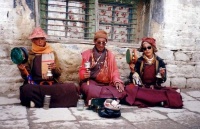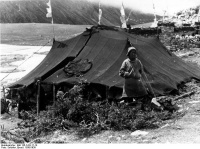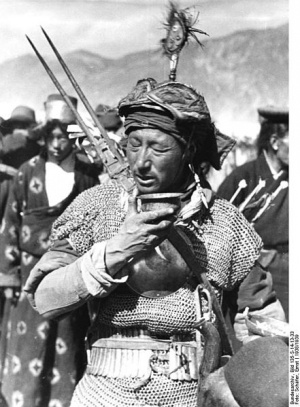Tibetan people


The Tibetan people (Tibetan: བོད་པ་, Wylie: Bodpa; Chinese: 藏族; pinyin: Zàng Zú) are an ethnic group that is native to Tibet. They number an estimate of 6.5 million. Significant Tibetan minorities also live outside of Tibet Autonomous Region (TAR) in China, and in India, Nepal, and Bhutan.
Tibetans speak the Tibetic languages, many varieties of which are mutually unintelligible. They belong to the Tibeto-Burman languages. The traditional, or mythological, explanation of the Tibetan people's origin is that they are the descendants of the human Pha Trelgen Changchup Sempa and rock ogress Ma Drag Sinmo. Most Tibetans practice Tibetan Buddhism, though some observe the indigenous Bön religion. Tibetan Buddhism influences Tibetan art, drama, and architecture, while the harsh geography of Tibet has produced an adaptive culture of Tibetan medicine and cuisine.
Demographics
As of 2010 Census, there are 6.2 million Tibetans living in Tibet Autonomous Region and Tibetan Autonomous Prefectures in People's Republic of China . The SIL Ethnologue in 2009 documents an additional 189,000 Tibetan language speakers living in India, 5,280 in Nepal, and 4,800 in Bhutan. The Central Tibetan Administration's (CTA) Green Book (Tibetan document) (of the Tibetan Government in Exile) counts 145,150 Tibetans outside Tibet: a little over 100,000 in India; in Nepal there are over 16,000; over 1,800 in Bhutan and more than 25,000 in other parts of the world. There are Tibetan communities in the United States, Australia, Canada, Costa Rica, France, Mexico, Norway, Taiwan, Switzerland, and the United Kingdom.
How the current numbers compare to Tibetans historically is a difficult claim. The CTA claims that the 5.4 million number is a decrease from 6.3 million in 1959 while the Chinese government claims that it is an increase from 2.7 million in 1954. However, the question depends on the definition and extent of "Tibet"; the region claimed by the CTA is more expansive and China more diminutive. Also, the Tibetan administration did not take a formal census of its territory in the 1950s; the numbers provided by the administration at the time were "based on informed guesswork".
The Tibetan population growth is attributed by PRC officials to the improved quality of health and lifestyle of the average Tibetan since the beginning of reforms under the Chinese governance. According to Chinese sources, the death rate of women in childbirth dropped from 5,000 per 100,000 in 1951 to 174.78 per 100,000 in 2010, the infant mortality rate dropped from 430 infant deaths per 1,000 in 1951 to 20.69 per 1,000 by the year of 2010. The average life expectancy for Tibetans rose from 35.5 years in 1951 to over 67 years by the end of 2010. Infant mortality in China as a whole was officially rated 14 per 1,000 in 2010.
Language
The Tibetan language encompasses many dialects. Khampas have several Khams language dialects which may be unintelligible to Amdowas, and the Lhasa dialect may be unintelligible to both of those groups.
Physical characteristics
Tibetans are phenotypically diverse. Recent research into the ability of Tibetans' metabolism to function normally in the oxygen-deficient atmosphere above 4,400 metres (14,400 ft) shows that, although Tibetans living at high altitudes have no more oxygen in their blood than other people, they have ten times more nitric oxide and double the forearm blood flow of low-altitude dwellers. Nitric oxide causes dilation of blood vessels allowing blood to flow more freely to the extremities and aids the release of oxygen to tissues. This and other advantages in physiological function at high altitudes have been attributed to a mutation in the EPAS1 gene among Tibetans.
Origins
Genetics
In 2010, one Tibetan study of genomic variation suggests that the majority of the Tibetan gene pool may have diverged from the Han around 3,000 years ago. However, there are possibilities of much earlier human inhabitation of Tibet, and these early residents may have contributed to the modern Tibetan gene pool. Further anthropological and genetic studies will be needed to clarify the history of human settlement in Tibet.
The distribution of Haplogroup D-M174 is found among nearly all the populations of Central Asia and Northeast Asia south of the Russian border, although generally at a low frequency of 2% or less. A dramatic spike in the frequency of D-M174 occurs as one approaches the Qinghai-Tibetan Plateau of western China. D-M174 is also found at high frequencies in Japanese people, but it fades into low frequencies in Korea and China proper between Japan and Tibet.
The romantic claim that American Navajo and Tibetans are related has not found support in genetic studies. Some light has been shed on their origins, however, by one genetic study in which it was indicated that Tibetan Y-chromosomes had multiple origins, one from Central Asia while the other from East Asia.
Mythology
Within Tibetan mythology, the origins of Tibetans are said to be rooted in the marriage of the monkey Pha Trelgen Changchup Sempa and rock ogress Ma Drag Sinmo.
Religion

- See also :
- See also :
Most Tibetans generally observe Tibetan Buddhism or a collection of native traditions known as Bön (also absorbed into mainstream Tibetan Buddhism). There is a minority Tibetan Muslim population. There is also a small Tibetan Christian population in the eastern Tibet and northwestern Yunnan of China.
Legend said that the 28th king of Tibet, Thothori Nyantsen, dreamed of a sacred treasure falling from heaven, which contained a Buddhist sutra, mantras, and religious objects. However, because the Tibetan script had not been invented, the text could not be translated in writing and no one initially knew what was written in it. Buddhism did not take root in Tibet until the reign of Songtsän Gampo, who married two Buddhist princesses, Bhrikuti of Nepal and Wencheng of China. It then gained popularity when Padmasambhāva visited Tibet at the invitation of the 38th Tibetan king, Trisong Deutson.
Today, one can see Tibetans placing Mani stones prominently in public places. Tibetan lamas, both Buddhist and Bön, play a major role in the lives of the Tibetan people, conducting religious ceremonies and taking care of the monasteries. Pilgrims plant prayer flags over sacred grounds as a symbol of good luck.
The prayer wheel is a means of simulating chant of a mantra by physically revolving the object several times in a clockwise direction. It is widely seen among Tibetan people. In order not to desecrate religious artifacts such as Stupas, mani stones, and Gompas, Tibetan Buddhists walk around them in a clockwise direction, although the reverse direction is true for Bön. Tibetan Buddhists chant the prayer "Om mani padme hum", while the practitioners of Bön chant "Om matri muye sale du".
Culture

Tibet is rich in culture. Tibetan festivals such as Losar, Shoton, Linka (festival), and the Bathing Festival are deeply rooted in indigenous religion and also contain foreign influences. Each person takes part in the Bathing Festival three times: at birth, at marriage, and at death. It is traditionally believed that people should not bathe casually, but only on the most important occasions.
Art
Tibetan art is deeply religious in nature, from the exquisitely detailed statues found in Gonpas to wooden carvings and the intricate designs of the Thangka paintings. Tibetan art can be found in almost every object and every aspect of daily life.
Thangka paintings, a syncretism of Indian scroll-painting with Nepalese and Kashmiri painting, appeared in Tibet around the 8th century. Rectangular and painted on cotton or linen, they usually depict traditional motifs including religious, astrological, and theological subjects, and sometimes a mandala. To ensure that the image will not fade, organic and mineral pigments are added, and the painting is framed in colorful silk brocades.
Drama
The Tibetan folk opera, known as Ache lhamo, which literally means "sister goddess" or "celestial sister," is a combination of dances, chants and songs. The repertoire is drawn from Buddhist stories and Tibetan history.
Tibetan opera was founded in the fourteenth century by Thangthong Gyalpo, a lama and a bridge builder. Gyalpo, and seven girls he recruited, organized the first performance to raise funds for building bridges, which would facilitate transportation in Tibet. The tradition continued uninterrupted for nearly seven hundred years, and performances are held on various festive occasions such as the Lingka and Shoton festival. The performance is usually a drama, held on a barren stage that combines dances, chants, and songs. Colorful masks are sometimes worn to identify a character, with red symbolizing a king and yellow indicating deities and lamas. The performance starts with a stage purification and blessings. A narrator then sings a summary of the story, and the performance begins. Another ritual blessing is conducted at the end of the play. There are also many historical myths/epics written by high lamas about the reincarnation of a "chosen one" who will do great things.
Architecture
The most unusual feature of Tibetan architecture is that many of the houses and monasteries are built on elevated, sunny sites facing the south. They are commonly made of a mixture of rocks, wood, cement and earth. Little fuel is available for heating or lighting, so flat roofs are built to conserve heat, and multiple windows are constructed to let in sunlight. Walls are usually sloped inwards at 10 degrees as a precaution against frequent earthquakes in the mountainous area. Tibetan homes and buildings are white-washed on the outside, and beautifully decorated inside.
Standing at 117 metres (384 ft) in height and 360 metres (1,180 ft) in width, the Potala Palace is considered the most important example of Tibetan architecture. Formerly the residence of the Dalai Lama, it contains over a thousand rooms within thirteen stories and houses portraits of the past Dalai Lamas and statues of the Buddha. It is divided between the outer White Palace, which serves as the administrative quarters, and the inner Red Quarters, which houses the assembly hall of the Lamas, chapels, 10,000 shrines, and a vast library of Buddhist scriptures.

Medicine
Tibetan medicine is one of the oldest forms in the world. It utilizes up to two thousand types of plants, forty animal species, and fifty minerals. One of the key figures in its development was the renowned 8th century physician Yutok Yonten Gonpo, who produced the Four Medical Tantras integrating material from the medical traditions of Persia, India and China. The tantras contained a total of 156 chapters in the form of Thangkas, which tell about the archaic Tibetan medicine and the essences of medicines in other places.
Yutok Yonten Gonpo's descendant, Yuthok Sarma Yonten Gonpo, further consolidated the tradition by adding eighteen medical works. One of his books includes paintings depicting the resetting of a broken bone. In addition, he compiled a set of anatomical pictures of internal organs.
Cuisine
The Cuisine of Tibet reflects the rich heritage of the country and people's adaptation to high altitude and religious culinary restrictions. The most important crop is barley. Dough made from barley flour, called tsampa, is the staple food of Tibet. This is either rolled into noodles or made into steamed dumplings called momos. Meat dishes are likely to be yak, goat, or mutton, often dried, or cooked into a spicy stew with potatoes. Mustard seed is cultivated in Tibet, and therefore features heavily in its cuisine. Yak yogurt, butter and cheese are frequently eaten, and well-prepared yogurt is considered something of a prestige item.
Clothing
Most Tibetans wear their hair long, although in recent times due to Chinese influence, some men do crop their hair short. The women plait their hair into two queues, the girls into a single queue.
Because of Tibet's cold weather, the men and women wear long thick dresses (chuba). The men wear a shorter version with pants underneath. The style of the clothing varies between regions. Nomads often wear thick sheepskin versions.
Literature
Tibet has national literature that has both religious, semi-spiritual and secular elements. While the religious texts are well-known, Tibet has the semi-spiritual Gesar Epic, which is the longest epic in the world and is enjoyed by people in Mongolia and Central Asia too. There are secular texts such as The Dispute Between Tea and Chang (Tibetan beer) and Khache Phalu's Advice.
Marriage customs
Polyandry is practiced in parts of Tibet. A typical arrangement is where a woman may marry male siblings. This is usually done to avoid division of property and provide financial security. However, monogamy is more common throughout Tibet. Marriages are sometimes arranged by the parents, if the son or daughter has not picked their own partner by a certain age.
